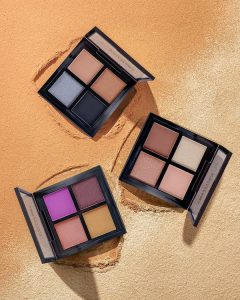Eyeshadow Color Combinations


Eyeshadow Color Combinations: A Guide to Stunning Eye Makeup


Choosing the right eyeshadow colors can transform your eye makeup and enhance your overall look. Whether you’re going for a natural everyday look or a glamorous evening look, the right color combinations can make a world of difference. In this article, we’ll explore various eyeshadow color combinations and provide step-by-step instructions on how to create stunning eye makeup. Let’s dive in!
Understanding Eyeshadow Color Theory
Before we delve into specific color combinations, it’s important to understand the basics of eyeshadow color theory. The color wheel is a valuable tool for creating harmonious eyeshadow looks. Here are some key terms to know:
Complementary Colors
Complementary colors are those that sit opposite each other on the color wheel. When used together, they create a high-contrast, striking effect. For example, the complementary color of blue is orange, and the complementary color of purple is yellow.
Analogous Colors
Analogous colors are those that are adjacent to each other on the color wheel. These colors create a harmonious and cohesive look when used together. For example, green and blue are analogous colors, as are orange and red.
Monochromatic Colors
Monochromatic colors are shades and tints of the same color. Using different shades of a single color can create a sophisticated and cohesive eyeshadow look.
Classic Eyeshadow Color Combinations
Now that we have a basic understanding of color theory, let’s explore some classic eyeshadow color combinations that are sure to elevate your eye makeup:
1. Neutral Browns and Golds
This classic combination works well for both daytime and evening looks. The warm tones of brown and gold complement a variety of eye colors. Follow these steps to achieve this look:
Step 1: Apply a Base Shade
Start by applying a matte, neutral brown shade all over your eyelids as a base color.
Step 2: Define the Crease
Using a slightly darker brown shade, apply it to the crease of your eyelids and blend well for added depth.
Step 3: Add a Pop of Gold
Apply a shimmery gold eyeshadow to the center of your eyelids and blend it with the brown shades. This will create a beautiful contrast and add dimension to your eyes.
Step 4: Highlight the Inner Corner
Finish the look by applying a light gold or champagne shade to the inner corner of your eyes. This will brighten and open up your eyes.
2. Smoky Grays and Silvers
The smoky eye is a timeless and sultry look that works for various occasions. Here’s how to achieve a smoky gray and silver eyeshadow look:
Step 1: Apply a Base Shade
Start by applying a matte gray shade all over your eyelids as a base color.
Step 2: Define the Crease
Use a slightly darker gray shade to define your crease and outer corner. Blend well to create a seamless transition of colors.
Step 3: Add Shimmer
Apply a silver eyeshadow to the center of your eyelids and blend it with the gray shades. This will create a smoky effect and add a touch of glamour.
Step 4: Line the Eyes
Complete the look by lining your upper lash line with a black or charcoal eyeshadow or eyeliner. This will intensify the smoky effect.
3. Bold Jewel Tones
If you want to make a statement, bold jewel tones are the way to go. Experiment with rich purples, deep blues, and vibrant greens for a stunning eye-catching look:
Step 1: Apply a Base Shade
Start by applying a matte shade in the jewel tone of your choice all over your eyelids as a base color.
Step 2: Define the Crease
Use a slightly darker shade in the same jewel tone to define your crease and outer corner. Blend well for a seamless transition.
Step 3: Add Shimmer
Apply a shimmery eyeshadow in a complementary jewel tone to the center of your eyelids. This will add dimension and make your eyes pop.
Step 4: Highlight the Inner Corner
Finish the look by applying a shimmery light shade, such as silver or gold, to the inner corner of your eyes. This will brighten and enhance the jewel tones.
Experimenting with Color
While the classic color combinations mentioned above are timeless and versatile, don’t be afraid to experiment with different colors and create your own unique looks. The key is to have fun and express your personal style. Here are a few tips to keep in mind:
1. Consider Your Eye Color
Take into account your eye color when choosing eyeshadow combinations. Certain colors can make your eyes stand out more. For example, purple tones can enhance green eyes, while golds and bronzes can complement blue eyes.
2. Blend, Blend, Blend
Blending is crucial for achieving a seamless and professional-looking eyeshadow application. Use a clean blending brush to soften any harsh lines and create a smooth transition between colors.
3. Use the Right Brushes
Invest in good-quality eyeshadow brushes that are specifically designed for blending, packing color, and precise application. The right brushes can make a significant difference in the overall result.
4. Practice Makes Perfect
Don’t be discouraged if your first attempts at experimenting with color combinations don’t turn out exactly as you envisioned. Like any skill, mastering eyeshadow application takes practice. Keep experimenting, trying new looks, and honing your technique.
Conclusion
Choosing the right eyeshadow color combinations can elevate your eye makeup and enhance your overall look. Whether you prefer classic neutrals, sultry smoky eyes, or bold jewel tones, there are endless possibilities to explore. Remember to consider color theory, blend your shades seamlessly, and have fun experimenting with different looks. With practice, you’ll become a pro at creating stunning eye makeup that highlights your unique beauty.








